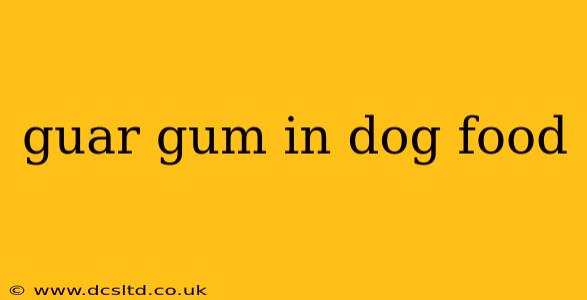Guar Gum in Dog Food: A Comprehensive Guide
Guar gum, a natural polysaccharide derived from the guar bean, is increasingly appearing in dog food ingredient lists. While its presence might raise questions for some pet owners, understanding its role and potential benefits can help you make informed decisions about your dog's nutrition. This comprehensive guide will delve into the uses, benefits, and potential concerns surrounding guar gum in canine diets.
What is Guar Gum and Why is it in Dog Food?
Guar gum acts as a thickening agent, stabilizer, and binder in various food products, including dog food. Its primary function in kibble and wet food is to improve texture and consistency. It helps bind ingredients together, preventing crumbling in dry food and creating a desirable viscosity in wet food. This leads to improved palatability and a more appealing texture for dogs. Beyond texture, it can also contribute to improved shelf life and prevent separation of ingredients.
Is Guar Gum Safe for Dogs?
The short answer is generally yes. Guar gum is considered safe for canine consumption by organizations like the FDA, and it's generally recognized as safe (GRAS) by the food industry. However, like any ingredient, excessive consumption can lead to issues.
What are the Benefits of Guar Gum in Dog Food?
- Improved Texture and Palatability: As mentioned, guar gum enhances the texture and makes the food more appealing to dogs, encouraging them to eat.
- Increased Satiety: Guar gum can absorb water in the digestive tract, which can help promote a feeling of fullness. This can be beneficial for dogs prone to overeating or those needing to manage their weight.
- Improved Digestibility: While not directly aiding digestion itself, the improved texture and binding properties can contribute to better digestibility by preventing crumbling and improving the overall food consistency.
- Reduced Blood Sugar Spikes: Some studies suggest that guar gum can help regulate blood sugar levels, although more research specific to canines is needed. This might be beneficial for dogs with diabetes or those at risk of developing the condition.
Can Guar Gum Cause Digestive Issues in Dogs?
While generally safe, excessive consumption of guar gum can lead to digestive upset in some dogs. This can manifest as diarrhea, gas, or bloating. This is more likely to occur if your dog consumes a large amount of guar gum in a short period. Moderate amounts used in commercially produced dog food are not usually a concern.
How Much Guar Gum is Too Much for My Dog?
There isn't a precise amount of guar gum that's definitively "too much" for every dog. This varies based on the dog's size, breed, overall health, and individual sensitivities. The key is moderation. As guar gum is a relatively inert ingredient, the amounts typically found in commercial dog food are generally considered safe. However, if you notice any digestive upset after introducing a new food containing guar gum, consult your veterinarian.
Are there any alternatives to guar gum in dog food?
Yes, many other ingredients can serve similar purposes in dog food. These include xanthan gum, locust bean gum, and other natural and synthetic thickening agents. The choice of which to use often depends on the manufacturer’s preference and the desired properties of the final product.
Is Guar Gum a Necessary Ingredient in Dog Food?
No, guar gum is not a necessary ingredient for a dog's health. A balanced diet containing all essential nutrients is far more crucial. Guar gum primarily serves to improve the texture, processing, and shelf life of the food.
In conclusion, guar gum is generally considered safe for dogs when used in moderation as found in commercially prepared dog food. However, if your dog exhibits any adverse reactions, consult your veterinarian. Choosing high-quality dog food from reputable brands is always recommended to ensure your dog receives complete and balanced nutrition. Remember to always monitor your dog's response to any new food and adjust their diet as needed based on your veterinarian's advice.
